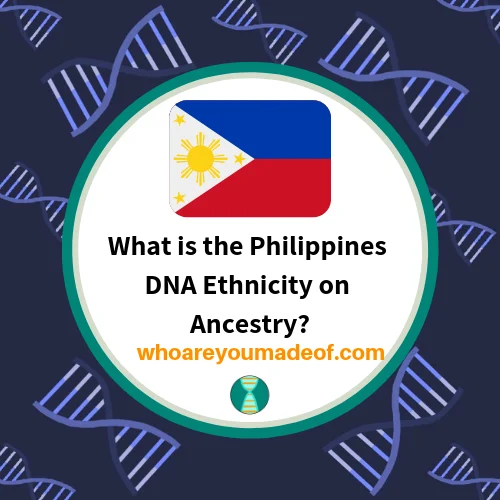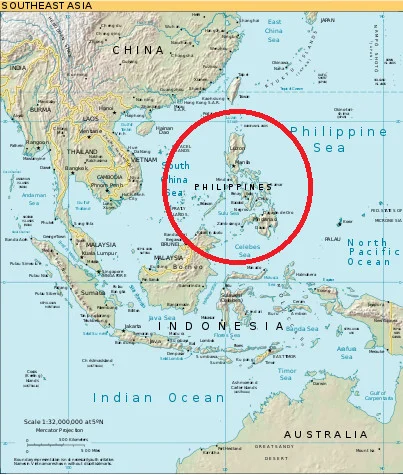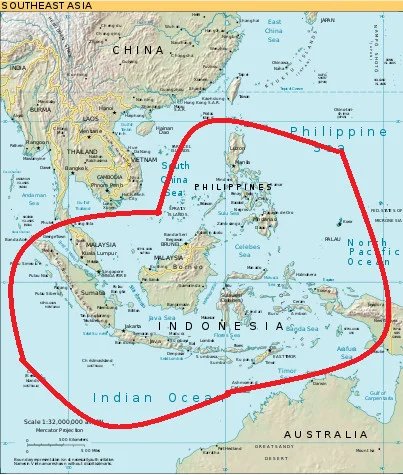Did you get your DNA results back and discover that you match the Philippines DNA region on Ancestry? If so, you can count yourself among the more than ten million people with Filipino ancestry outside of the Philippines living in countries all over the world.
In this post, you'll learn:
- Where the Philippines DNA ethnicity region is located
- Why there is Filipino DNA outside of the Philippines
- How to figure out how far back your Filipino ancestors might be based on your ethnicity estimate
- Whether you might be able to trace your family tree to find out who your ancestors were from the Philippines

Even if you are surprised by your Filipino DNA results, this post will help you analyze your ethnicity estimate to determine just how you might have inherited your Filipino DNA.
Haven't tested your DNA yet? Read this post to learn how Filipino DNA shows up on Ancestry DNA.
Where is the Philippines DNA Ethnicity on Ancestry located?
The Philippines DNA Ethnicity region is located in the islands of the Philippines, southeast of China. The country of the Philippines is made up of more than seven thousand islands in the South China and Philippine Seas.
Many of the islands are unnamed, and only about 2,000 of the 7,000 are inhabited. There are about 108 million total people living in the Philippines as of 2019.
In the map below, you can see the location of the main Philippine DNA region on Ancestry.

Even though the Philippines DNA region on Ancestry DNA is primarily located within the islands of the Philippines, you can also find significant DNA from this region in Indonesia and Malaysia. The map below outlines the greater Philippine DNA region where you are likely to find people with Filipino DNA:

Why is there Philippine DNA outside of Asia?
You can find significant populations of Filipinos, or people of Filipino descent, living in more than 100 countries worldwide. The Filipino diaspora (people of Filipino descent living outside of the Philippines) is one of the largest in the world.
To illustrate the sheer number of people with roots in the Philippines living elsewhere, check out these facts:
- 4 million people living in the United States have Filipino ancestry
- More than 1 million Filipinos live in Saudi Arabia
- 850,000 Canadians have Filipino heritage or were born in the Philippines
Hundreds of thousands of Filipinos also live in the following countries, and many thousands more live in dozens of other countries too numerous to list:
- Malaysia
- Australia
- Japan
- Qatar
- Kuwait
- Italy
- Spain
- Hong Kong
People left the Philippines over the past few hundred years for many reasons. Natural disasters, wars, political factors, and economic opportunities motivated or encouraged people to leave the Philippines in search of a more secure future elsewhere.
Examples of situations that led people to leave the Philippines include:
- The eruption of Mount Taal in 1911
- The Tagalog War (fought to achieve independence from Spain)
- The Spanish-American War in 1898
Surprised by your Filipino DNA? Think outside the box
During Mexico's colonial period, many immigrants from the Philippines settled in Mexico. Many of them came to Mexico as a result of the Manila-Acapulco Galleon, which were Spanish trading ships that traveled between Acapulco, Mexico, and Manila, Philippines for more than two hundred years.
More than 1 million Mexicans have Filipino ancestry, with most of them residing in the Mexican states of Guerrero, Michoacán , and Colima.
Many of the Filipinos who traveled via these Spanish trade ships were enslaved crew, and even those who weren't enslaved were often poorly treated and not justly compensated for their work. This led many to flee to other parts of North America.
While exact dates are disputed, the village of St. Malo, Louisiana was settled, most likely, towards the end of the 1700s. The Filipino settlers of this town were known as "Manila Men" and eventually intermarried with Native American, African-American, and Cajun women.
Even more interestingly, St. Malo is now recognized as the oldest Asian-American settlement in the United States!
Even if you aren't from Louisiana or don't have ancestors who lived in those Mexican states that I mentioned, it still might pay to do some research on the local history of the places where your known ancestors did live. You never know what unusual (and exceptionally interesting!) information your investigations might turn up, and the branches that might grow on your family tree.
How far back your Filipino ancestors might be based on your ethnicity estimate?
Did you get 25% Filipino? 12%? 56%? 2%? Is there any way to use the percentage of Filipino DNA that showed up on your ethnicity estimate to figure out how far back your ancestry in the Philippines is?
Our ethnicity estimates can provide some clues as to how far back in our family tree we would need to look to find ancestors from a particular region. The basic rule of thumb that works fairly well with very recent ancestry in the Philippines (or anywhere else!) is as follows:
- Assuming you begin with an ancestor who has 100% Philippines DNA, the child of that ancestor would have had 50% Philippines DNA, the grandchild would have 25%, and the great-grandchild would have 12.5%.
This "rule of thumb" doesn't always work in perfect 50% increments, however. This is especially true if your Filipino ancestry is more distant than a grandparent, or if your Filipino ancestor wasn't 100% Filipino (from a genetic perspective).
Why?
While it's true that each person does inherit 50% of their DNA from their parents, they only get half of each of their parents' DNA. In addition, there is no way to know which half of our parents' DNA we will inherit.
If our dad is 50% Filipino and 50% Spanish, we will definitely inherit some Spanish and some Filipino, but we might get 20% Filipino and 30% Spanish, or 15% Spanish and 35% Filipino, or any other sort of combination that is definitely not the even 50/50 split that we might expect.
Your DNA matches can help you figure out how far back your Filipino ancestry is
While ethnicity estimates are cool, the real gem in your DNA result is your DNA match list. Hidden among your DNA matches is the real key to figuring out how far back your Philippines ancestry is in your family tree.
What does it mean to have a high percentage of Philippines DNA?
If you have a high percentage (more than about 20%) of Filipino DNA, then you have good reason to believe that you might have a Filipino grandparent. If you do have a grandparent from the Philippines, then there is a good possibility that you have lots of second, third, and fourth cousins who also have ancestry in the Philippines.
Lots of people from this region have done DNA tests, and you'll see DNA matches who have family trees with Filipino ancestors.
Note: It is possible to inherit some amount of the same ethnicity regions from both of our parents, so if you have reason to believe that both of your parents have ancestry in the Philippines, then you should take this into consideration. The "100% ancestor" that you are curious about might be twice as far back in your family tree.
For those with smaller percentages (less than 10%) of DNA from the Philippines, you still may be able to find traces of your ancestry from this region in your DNA matches. You can assume that your "100%" ancestor from the Philippines is more distant than a great-grandparent and so you should look among your 3rd-4th cousins for family trees with Filipino ancestors.
Related topic: How is your DNA match related to you? Here's a checklist.
Trace Filipino DNA
If you have a very small percentage of DNA from the Philippines (less than 5%, approximately), and you don't find any evidence that your DNA matches have ancestry from the Philippines (based on their family trees), then you can assume (for now!) that your ancestry from the region is very distant.
Can you trace your Filipino family tree?
DNA matches and ethnicity estimates aside, the best way to figure out how you inherited your Filipino DNA is to start building a family tree. Beginning with yourself, and continuing with your parents and grandparents, you can piece together the story that makes you uniquely you.
I recommend building your family tree on Ancestry, especially if you have tested with Ancestry DNA. You can attach your family tree to your DNA results to get extra features, which are pretty cool.
It's free to build your tree on Ancestry, but if you want to have access to documents, photographs, records, and other family trees (built by other members who might share ancestors with you), you will need to have a subscription.
Conclusion
I hope that this post helped you learn more about your Philippine DNA ethnicity, how you might have inherited it, and how to go about tracing your Filipino roots.
If you have any questions about something that you read in this post or would like to share your own Filipino DNA results, I would love to hear from you in the discussion below.
Thanks for being here!


Kyon
Friday 3rd of February 2023
Wow! This information was truly helpful! I have tested on both ancestryDNA & 23AndMe, with both results showing Filipino ancestry. While the percentage is pretty low (1% via ancestryDNA and nearly 2% on 23AndMe), it hasn't changed in the over 5 years that I've taken this test. That's why it's become an interesting topic for me (it's the only "low confidence region" that has remained. Well that and East Asian).
Both of my parents have taken this test and Filipino shows up in my dad's ancestry as well (1% on AncestryDNA). Ancestry says it's on his paternal side (says the same for me). Funny enough, his family comes from the Florida panhandle and have a looong history there. I've traced his family back to a native family via records and books written by visitors. This article definitely made the possible origins of the Filipino ancestry make a little more sense.
Thanks!
J Bumatay
Friday 26th of November 2021
My grandfather was Illocano. He came to the US as an Immigrant Farm Worker and retired as a Machinist from a US Naval Nuclear Submarine Base. My father was half Scots Irish Cherokee. My grand parents were born over a hundred years ago and lived as traditional people. Although my grandfather worked full time for the US government, he came home, watered the garden on a quarter acre filled with fruit trees and vegetables, peppers and peppermint plants. Them he came in and chopped the meat and vegetables. My grandmother made all the stews for the meat, etc. She sewed on a hundred plus year old Singer foot pedal sewing machine and crothethed fine lace for whatever needed. She had them all over place mats. So, yeah, I learned all about my grandfather's heritage from him. My father had and brothers and nephews have Y O-F78.
Sabrina
Saturday 6th of March 2021
I have the Philippines ancestry on my Ancestry dot com estimate. It also shows up on 23 and me. I believe mine came from those "Manilamen" from 18th Century Louisiana. Several of my more recent ancestors come from the Gulf region, primarily Mobile, Alabama with some in New Orleans, Southernmost Mississippi and the Florida panhandle.
Mercedes
Sunday 7th of March 2021
Hi Sabrina, That is absolutely fascinating, and I hope that you are able to learn more about your ancestry in the Gulf region, as it does have a very complex and rich history. Sincerely, Mercedes